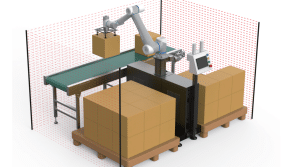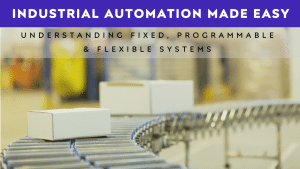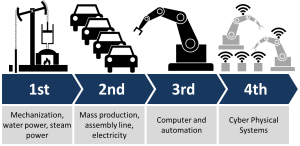Introduction to Return on Investment (ROI)
Automation has been transforming the way businesses operate and has the potential to significantly increase efficiency, reduce costs, and improve product quality. However, UK companies are still struggling to invest. It is the only G7 country with a robot density below the global average of 126 installations per 10,000 factory workers. (link) Like any investment, it’s important to carefully evaluate the potential return before committing resources, but many businesses are looking at automation investment incorrectly.
In this blog, we’ll explore the factors contributing to Return on Investment (ROI) in automation and provide insights on maximising the benefits of automation while minimizing the risks. We’ll look at some case studies of how to evaluate “return” and look at different metrics you might use. Whether you’re a business owner or a manager looking to improve your operations, this article will provide valuable information on how to construct a business case and make informed decisions about investing in automation.
Possible Factors Contributing to ROI in Automation
How your business case is constructed is based on what the goal of your automation implementation project will be. There are a variety of reasons to automate, including:
- Cost savings in labour
- Increased production speed and capacity
- Improved product quality and consistency
- Reduction in errors and waste
- Health & Safety improvements or requirements
The traditional way to calculate ROI is using labour cost savings, this is often the “easiest” way to evaluate return, but it is often exceedingly conservative. We will look at how some of the other goals and their metrics can be used to justify the investment in your project more successfully.
What is ROI?
According to Investopedia, in simple terms, return on investment (ROI) tells you how much money you’ve made (or lost) on an investment or project after accounting for its cost. In other words, how much more money will I have because I made this investment? Take a simple savings account at a bank as an example, that 2% compounded interest on a £100 investment will net you £2 per year. When you use the formula:
ROI = final Value of investment – cost of investment
And from that formula, you see you have a 2% return.
With capital investments in industrial settings, the ROI is usually viewed in “time until payback”. What this means is: if I invest my money, I will create a surplus by doing something faster, cheaper, or with less waste. I can calculate how long it will take until that investment is recovered and when I will start pocketing that surplus (return). This seems like a straightforward calculation, but how you calculate that surplus and what your actual savings (or increased profit) are can be tricky.
Calculating ROI in Automation
We’ll look at a couple of ways of calculating ROI with some pros and cons for each.
Pay for investment with savings from labour reduction
The traditional ROI calculation with automation investment is to use labour cost savings. An example of this sort of calculation is below:
Example 1
Let’s assume we have an automation project which costs £100,000. It is automating a process which currently costs £1 to complete and we complete this process 35,000 times per year.
| Inputs | |
|---|---|
| Project Cost | £100,000 |
| Labour cost of existing process [per piece] | £1 |
| Qty of pieces [per year] | 35,000 |
We then look at our current annual labour cost (£35,000) and our future annual labour cost (£0) and subtract the two to get our “savings” (£35,000).
| Calculations | |
|---|---|
| Labour cost [per year] | £35,000 |
| Future labour costs [per year] | £0 |
We calculate our ROI by dividing our project costs, by our savings and seeing how many years until we break even or have “paid back” our investment.
| Results | |
|---|---|
| Labour cost saved [per year] | £35,000 |
| Time to payback [years] | 3.333 (£100k investment / £35k annual savings) |
Labour Cost Reduction Takeaways
The positives with this type of business case is that it is easy to understand and easy to evaluate with an investment policy (An investment policy might say something like: investments must be less than 5 years).
The negative of this is that most of the time businesses are not actually saving this labour cost. A savings only happens if a business cuts the size of the workforce, either in hours or headcount. However, this is not usually the case. Most companies, (at least the SME’s we work and talk with) are not looking at losing workers but repurposing them to something more valuable. So, these labour savings are false savings: no cost was actually saved, only capacity gained. Let’s look at the next way to look at ROI: using Capacity Release.
Capacity Release
When most automation projects are started there is a general understanding that this will increase the throughput of the business. However, this fact isn’t usually used to calculate the ROI because capacity increase can be difficult to quantify. However, we will look at two possible ways to look at it. One is on the “micro” scale. This is a detailed look at the types of jobs and their frequency your workers used to do and then compare them against the new ones, which they will do after the automation implementation. The second way is a more “macro” evaluation looking at total revenue and profit coming out of your factory.
Micro level view – Capacity Release
We’ve said that the Micro Level view is about looking at the specific tasks being done before and after the automation implementation. But, let’s use another example to see what that means.
Example 2
Let’s start with the basis of Example 1 from above and expand it. We’ll call the product we started to define in Example 1 “Product A”. The project costs are still £100,000 and the labour cost is still £35,000 annually.
| Example 1 Inputs for Product A and Product B | |
|---|---|
| Project Cost | £100,000 |
| Labour cost of existing process [per piece] | £1 |
| Qty of pieces [per year] | 35,000 |
Let’s assume Product A has £1 of material cost, on top of the £1 of labour cost, for a total cost of £2. We will also assume that we have a companywide margin set at %50.
| Product A | Inputs |
|---|---|
| Material Cost [per piece] | £1 |
| Margin | 50% |
For this type of ROI calculation, the “return” we are using is the total profit for the product, so we will start by determining total revenue, which for Product A is £140,000.
| Product A | Calculations |
|---|---|
| Total cost (Labour + material) [per piece | £2 (£1 + £1) |
| Selling price (with 50% margin) [per piece] | £4 |
| Total revenue (Selling price x annual qty) [per year] | £140,000 (£4 x 35,000) |
Finally, we calculate our profit as £70,000.
| Product A | Results |
|---|---|
| Profit [per year] | £70,000 (50% margin) |
However, after automation, if we will move that worker to another product (Product B). For Product B, we have a product with the same amount of labour (£1) but assume a material cost of £9 (instead of £1). The required margin remains the same.
| Product B | Inputs |
|---|---|
| Material Cost [per piece] | £9 |
| Margin | 50% |
Our total cost for this new product is £10, the selling price is £20, and the total revenue is £700,000.
| Product B | Calculations |
|---|---|
| Total cost [per piece | £10 |
| Selling price [per piece] | £20 |
| Total revenue [per year] | £700,000 (£20 x 35,000) |
For Product B we will generate £350,000 in profit
| Product B | Results |
|---|---|
| Profit [per year] | £350,000 (50% margin) |
If we use this £350,000 increase in annual profit as our return on our £100,000 investment, we have a ROI of about 4 months!
Takeaways of Micro Level View – Capacity release
The advantage of using the Micro level View of capacity release for ROI is that this is a true payback period, and the numbers tend to be more generous for justifying investment.
The negatives are that calculating what a “hypothetical” person will be doing after the implementation is difficult. Usually, this isn’t one person and they’re not just moving to one new job. It may be multiple people moving across many tasks on multiple products. This complexity lends itself to using a high-level method and dealing with the averages.
What’s next for ROI?
So far we have covered the Labour Cost Reduction and the Micro Level View of Capacity Release for calculating ROI. Check out part 2 of our ROI articles to find out an easier way to calculate and justify automation ROI and how to handle some unique automation applications.





